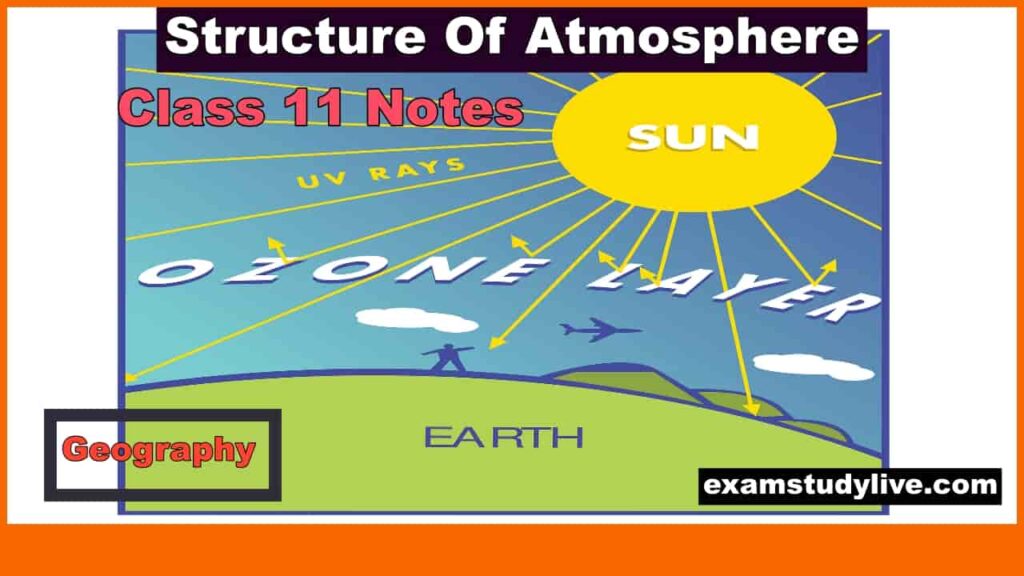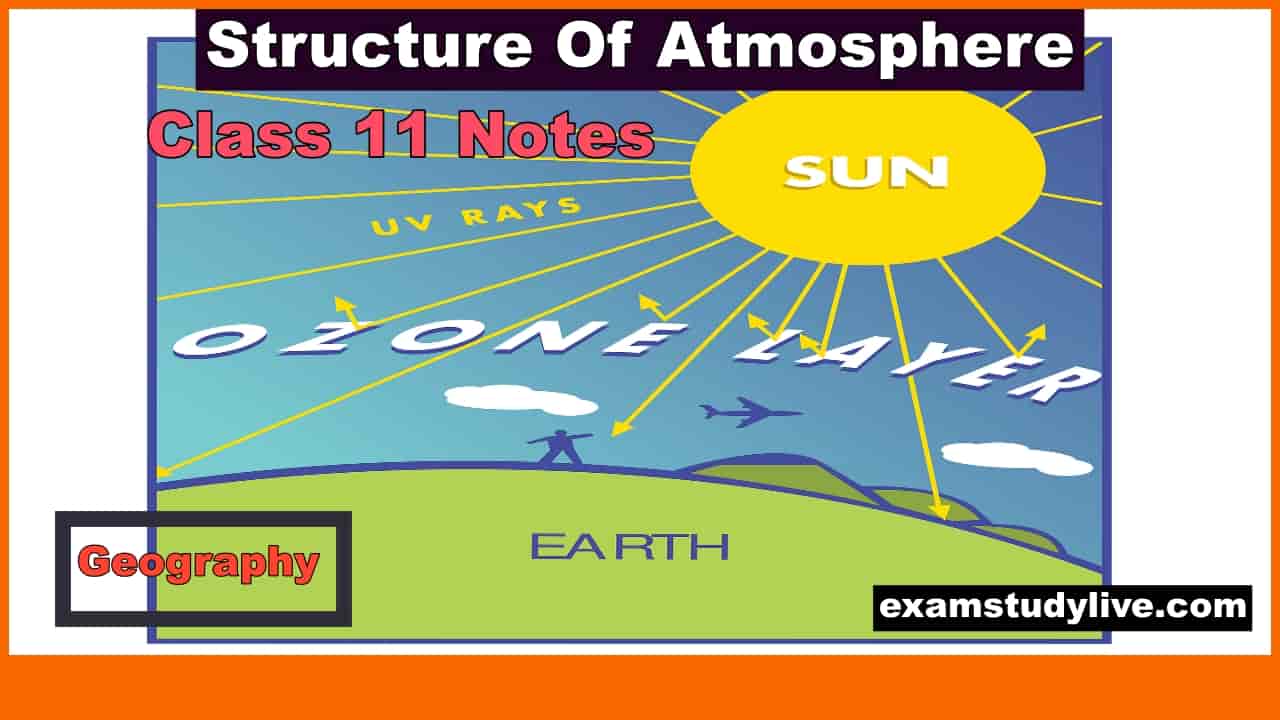What is the atmosphere?
Definition: Atmosphere is a combination of two words ‘Atmo’ and ‘sphere’. This means that part of the Earth is ‘air’. Various scientists have defined the ‘atmosphere’ in their own way. (Structure Of Atmosphere Class 11 Notes)

Historical Timeline
Information about atmospheric science, like other branches of science, begins with ideas and theories put forward by ancient Roman and Greek philosophers. Greek thinkers first published documents on the atmosphere in 400 BC.
There is a deadlock in relation to information due to the dark weather that damaged it in the 15th and 16th centuries.
Importance Of Atmosphere
1. The atmosphere is a storage layer between outer space and land space.
2. It is the source of gases necessary for the existence and continuation of life.
3. It filters the harmful rays that travel the Earth and protects the Earth from the intense heat that can produce ultraviolet (UV) rays.
4. Atmospheric conditions have the most impact on the flora and fauna of the earth.
5. It also provides vital energy to the life cycle.
6. The atmosphere helps to distribute solar energy to the earth vertically and horizontally.
Extent
As compared to the past, we have more information about the atmosphere presently but still scientists have various divergent opinions about related facts with the help of satellites the height of the atmosphere is varying between “16000 to 32000 Kms”. while the portion of the atmosphere upto ten kilometers part closest to the Earth is most important for weather and human life.
The extent of Atmosphere
Compared to the past, we have a lot of information about the atmosphere at the moment, but there are still scientists who hold different opinions about the facts associated with the help of satellites, the altitude of the atmosphere varies from 16000 to 32000 Km The nearest airfield ten kilometers from Earth is very important for human life and weather.
Composition of Atmosphere
Nitrogen: Nitrogen content (78.03%) is higher in the atmosphere than other gases.
Oxygen: The amount of oxygen in the atmosphere is 20.11 percent, which is chemically very active and combines rapidly with other elements.
Carbon Dioxide: It contains 0.03% atmosphere and its production is from combustion.
Ozone: It is an important lifesaving gas and another form of oxygen. Its value is less than the reference in an atmosphere of about 0.0005% by volume.
Water vapor: Water vapor is gases that make sense of the presence of water in the atmosphere. About 90% of the water vapor is found in areas up to five kilometers from the earth and completely disappears at an altitude of eight kilometers.
Aerosols: Solid, liquid particles of different sizes suspended in air are called aerosols.
Also Read this : Class 11 Geography Chapter 2 Notes
(Structure Of Atmosphere Class 11 Notes)
Structure of Atmosphere
It is now clear that the atmosphere begins at the Earth’s surface, but scientists have given different opinions about its maximum height.
Based on the information provided by radar, rockets, balloons, and satellites, many scientists now agree that altitude is 29,000 km and that up to 800 km is considered an integral part of the layered atmosphere.
In terms of air pressure, temperature and weather pressure, 97% of the total gases in the atmosphere are located 29 km above the Earth, and only 50% of the gases are located up to 5.6 km.
With the help of advanced technological equipment in the 20th century, scientists have succeeded in solving important mysteries about the environment.
The atmosphere can be divided into layers or regions, each layer having its importance. The boundaries of these layers are set arbitrarily as other natural boundaries.
The structure of the atmosphere can be divided in two ways; In terms of temperature and in terms of chemical composition.
(Structure Of Atmosphere Class 11 Notes)
In terms of temperature, s. Peterson divided the atmosphere into five layers such as
1. Troposphere
2. Stratosphere
3. Mesosphere
4. Ionosphere
5. Exosphere (Thermosphere)
1. Troposphere :
It is very important for all organisms due to the very little layer of the environment and all functions and characteristics related to weather. such as Evaporation, rain, condensation, storm, lightning, etc.
Derived from this field. This layer contains about 75% mass of gases and almost all vapors and aerosols.
An important feature of this region is that in this part of the air, the temperature decreases with increasing height.
Under normal circumstances, the fall rate is 6.5 ° C per kilometer or 3.6 ° F per 1000 feet. It is also called the average rate of temperature drop.
This occurs when gases decrease with height, pressure, and decrease in aerosides as altitude increases. However, due to local factors, in some areas, these events are also reversible.
The altitude of the troposphere varies with the changing seasons and weather. This change was recorded in 173 lessers as compared to tropical regions and in winter towards poles in summer.
According to scientists, the height of the sphere is 16 km at the equator and 8 km at the poles.
Tropopause :
The area between the troposphere and the stratosphere, with an altitude of 1.5 km, is called the boundary of the troposphere
The temperature drop in this region ends with the name of the tropopause. A mixture of gases, air, and radiation. There were no weather events in the region.
The lowest temperatures in winter at these poles are at the equator (17 km high), with 700 summers – 450 C, and C (9 km high). The air pressure in this region is between 100 mbar at the equator and 250 mbar at the poles.
(Structure Of Atmosphere Class 11 Notes)
2. Stratosphere :
This sphere is 12 to 16 kilometers from the Earth’s surface and extends 50 kilometers, which is known for its isothermal characteristics.
Although scientists have different views about height, width, and temperature, this area in the lower layer of temperature does not change with increasing altitude, but at a height of 20 km from the stratosphere, absorbing violent rays of intensity.
The temperature for ozone gases begins to rise. At a height of 50 km, it is 00 Celsius (320 F).
The ozone-rich region is also known as the ozone layer. This gas is abundant from 15 to 35 kilometers from the Earth’s surface.
An oxygen molecule disintegrates into two oxygen atoms and rejoins one molecule. The molecules of the ozone layer are unstable, and their origin and decay are a gradual and continuous process.
Human activity such as sprays and synthetic chemicals applied to ergon, which are stable compounds of chlorine, fluorine, and carbon on Earth, have been shown to empty the ozone layer daily, but when the ozone layer reaches the outer environmental layer of vertical currents It reaches.
3. Mesosphere :
Above the upper boundary of the stratosphere, which extends from 50 174kms. above the surface of Earth, is the mesosphere, up to 80 km.
In this layer temperature again starts decreasing with the increase in height and at the upper boundary of this layer it touches down to -800 of 50 km it is 1 Mb and at height of 80 km it drops to 0.01 Mb.
3. Mesosphere:
50 174 km, above the upper boundary limit of the stratosphere. The mesosphere extends up to 80 km above the Earth’s surface.
This layer starts to temperature again with increasing altitude and increases to 50 km – 800 at the upper boundary of this layer at 1 km and 0.01 km at an altitude of 80 km
(Structure Of Atmosphere Class 11 Notes).
4. Ionosphere:
The height of this sphere is 80 to 640 km above the Earth’s surface.
Proud scientists who discovered this layer have shown Kennelly and Heaviside that with the help of radio waves.
The atoms and molecules of gases in this layer can be converted into electricity by adding and removing electrons. UV, X-rays, and gamma rays.
The short wavelength of solar energy (UV, X, L) is absorbed by the molecules and atoms of nitrogen and oxygen, because of raising the temperature to 10000 C under the pressure of this small atmosphere.
Due to the low air pressure, the temperature here is very different from the temperature felt on the surface of the Earth.
C point The air pressure in this layer is very low. In the upper layers of the ion system.
Depending on the height of the ionosphere, it can be divided into the following layers:
(Structure Of Atmosphere Class 11 Notes)
5. Exosphere:
It is the outer layer of the atmosphere and we do not know much about this layer. Its height is 640 km. Only helium and hydrogen are found in this layer. Also, the density of this layer is very low.
The basis of Chemical composition is divided into two parts-
a) Homosphere:
It starts at the Earth’s surface and reaches 90 km. In this region, all the gases are located in their exact proportions.
b) Hetrosphere:
The atmosphere above the homosphere does not fit in terms of gas composition.
Based on the presence of gases, the spheres are divided into four layers-
Oxygen layer = 90 to 200 km.
Nitrogen layer = 200 to 1100 km.
Helium layer = 1100 to 3500 km.
Layer of Hydrogen = 3500 km. Upstream, to the farthest extent of the environment.

